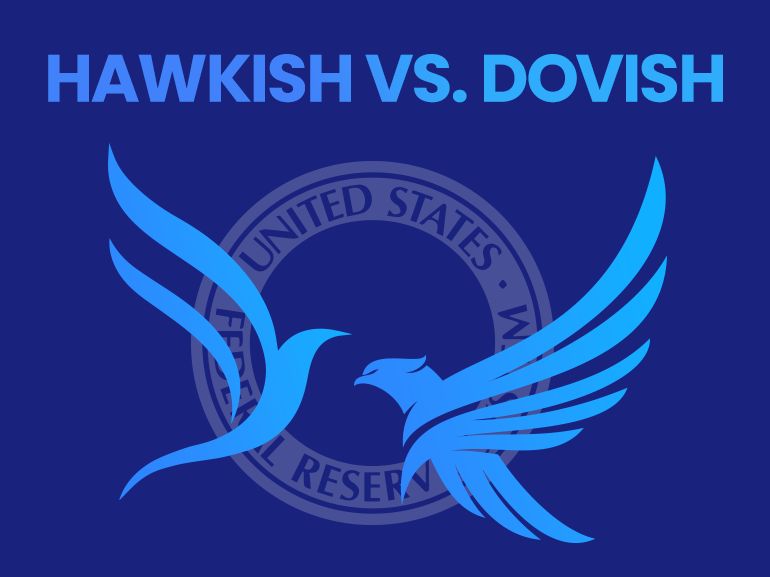Hawkish vs. Dovish: Monetary Policy Differences
Hawkish vs. Dovish are terms that have definitely made it to the headlines one way or another and especially in light of the rising inflation and recession fears these past couple of months.
Perhaps surprisingly, these two terms are used to define one of the world's largest and most influential central bank’s monetary policymakers, the Fed Reserve. So what are hawkish vs. dovish monetary policies exactly, how do these differ from one another, and are we in a hawkish or a dovish market now?

What Is the Fed Reserve?
The Federal Reserve is the US central banking system and is widely regarded as one of the most famous monetary systems in the world as its economic policies have a substantial effect on the US market, in particular, and the global markets in general.
In terms of segmentation, there are 12 Federal Reserve Banks in the US. Each bank is responsible for a specific geographical area and conducts monetary policy supervision, ensures financial stability, and provides banking services. Furthermore, each year, the Fed meetings eight times to decide on interest rates and monetary changes. It is important to note that these meetings play an important role in the economy and are widely anticipated by market watchers, traders, and consumers alike.
What Does Hawkish Policy Mean?
The term hawkish policy refers to the Federal Reserve’s monetary policy-making decisions especially when it comes to addressing inflation, which has dominated headlines for the past couple of months. As such, a hawk, as described in monetary jargon is a Federal Reserve monetary policy maker that combats inflation with higher interest rates. This may resonate with how many central banks like the ECB, the Fed Reserve, and the BoE have handled inflation throughout 2022 and 2023. In other words, hawkish policymakers are compared to hawks, which are birds of prey known for their aggressiveness.
What Does Dovish Policy Mean?
Unlike hawks, doves or those who hold a dovish monetary stance, opt for lower interest rates due to the fact that it is likely to increase the amount of money in circulation. In addition, dovish members prefer to maximize employment rates while supporting economic growth. While hawks are known for being predatory, inflation doves are meeker like pigeons or doves.
Examples of a Hawkish Policy
Perhaps one of the most prominent examples of the Fed’s hawkish policies is their monetary tightening trajectory adopted throughout the course of 2022. In an attempt to tame record-high inflation, the Fed raised rates by half a percentage point, to their highest level in 15 years in December of last year. This aggressive hiking policy was adopted throughout 2022 and not just in December. In addition, it was also revealed that Fed members expect intense rate hikes in the next two years as well.
Fed members who are hawkish are often referred to as hawks or inflation hawks. Famously known haws include Kansas City’s President, Esther George, Cleveland President Loretta Mester, and Atlanta’s Fed President, Raphael Bostic. (Source:Reuters)
Examples of a Dovish Policy
While many may be yearning for the Fed to adopt a more dovish tone, one of the most prominent and recent examples of dovishness is not actually related to the Fed but rather to the Bank of Japan (BoJ). Whereas many central banks including the Fed Reserve attempted to combat inflation with higher interest rates in 2022, the BoJ remained steadfast with its ultra-dovish tone throughout the year with extremely low rates. It did so with its yield curve control program.
However, despite the fact that the Fed has been more hawkish lately, some dovish Fed members include former Fed governor, Ben Bernanke, and former Fed Reserve Chair, Janet Yellen. Both of which were known for their devotion to keeping interest rates low. Current Fed members who tend to be more dovish include St. Louis’ President, James Bullard.
Advantages and Disadvantages of a Hawkish Policy
The advantages of a hawkish policy are that it may possibly lead to cheaper imports, higher savings rates, and can prevent inflation from escalating.
On the flip side, hawks may often be criticized by some for their views due to the fact that they are believed to be compromising economic health by raising interest rates. In other words, some believe that hawks may end up maximizing rates and neglecting employment rates and consumer spending which may lead to deflation, and make the cost of borrowing more expensive.
Advantages and Disadvantages of a Dovish Policy
Some would favor a dovish policy stance because of the possibility that it can increase employment rates and economic expansion. However, on the other hand, this comes with the cost of high inflation. This is because doves often favor employment rather than inflation and, therefore, opt for lower interest rates.
Are We in a Hawkish or Dovish Environment Now?
As it stands, many central banks including the US Fed Reserve, have been favoring more hawkish tones when it comes to tackling inflation and a possible recession. This means that we are in a relatively more hawkish market. Accordingly, higher interest rates were seen in most countries around the world. But whether or not this hawkishness will stick out throughout the rest of 2023, is yet to be determined.
Can Hawks Also be Doves?
It should be noted that Fed hawks can also turn into dovish and vis-a-vis. Take, for example, former Fed Chair Alan Greenspan who was known to be hawkish in 1987, but became more dovish over time. In addition, many Fed members, including Fed’s Chairman, Jerome Powell, can also be centrists.
Conclusion
While many think that the Fed may slowly be shifting away from its infamous hawkishness in 2023, others posit that this hawkish stance will probably carry through the rest of the year. Nonetheless, whether or not the Fed will ease its monetary tightening is yet to be determined. Traders and investors may have to wait and see what decisions they make in their upcoming meetings this year.
